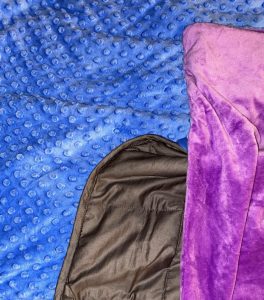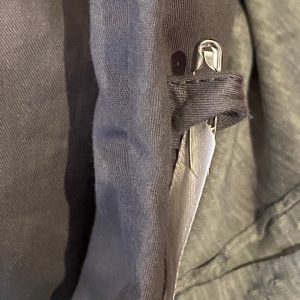Weighted Blankets
By Adam Glendon
Like a lot of specialty items associated with Autism, weighted blankets have become more mainstream as their popularity in the general population increased. Through online shopping we have seen a greater variety of choices. Not only on Amazon, I have seen weighted blankets on various websites like Costco and Bed Bath and Beyond. Weighted blankets are even in the malls with Showcase stores carrying them. With this, prices have come down and the new fills used have made for a better quality product.
What Are the Benefits of a Weighted Blanket?
Many Autistic people have sensitivity to touch. It has been shown that the deep touch pressure stimulation of a weighted blanket simulates the feeling of being held. This helps with a person ability to cope with the textures and feeling of clothes against their skin, the creepy crawly reaction when something brushes against them, and how they handle pain and temperature changes.
Like Temple Grandin’s hugging machine, the pressure against the body can have a calming effect helping you feel grounded, relaxed and secure. This can help regulate someone that is overwhelmed helping them to recover quicker. It can be used as a tool to help prevent a meltdown or be completely overwhelmed. If you are using it on a regular basis and your body knows how it will calm you or help you feel safe much like a baby benefits from being swaddled.
Please note: Weighted blankets are not recommended for children under 3 years or those that do not have the strength or coordination to easily move the blanket.
Technology & Quality
When I first investigated weighted blankets, over eight years ago, the most common weights (fill) was high density polyethylene beads. This created a thicker blanket that trapped more heat and is not environmentally friendly. There was added issue when these blankets were made overseas as you did not know the quality of beads used and if there were other chemicals that could leach out of the blanket. Today the two most popular fills are glass beads and ceramic beads. The result is a thinner blanket that is hypoallergenic.
To keep the fill from shifting around too much look for pocket size of 4″ x 4″ or smaller. Next look for multiple layers of fabric holding the weights in place. This also helps with lumpiness but will also help prevent leaks.
Before you buy, make sure you read the reviews. Watch for things like how easily the fabric punctures or tears causing the fill to leak out. Do not worry as much about people complaining about lumpiness. Weighted blankets will never be as smooth as a regular duvet and some people do not realize this. However, if there is a lot of negative reviews due to lumping or shifting fill you might want to look elsewhere.
Sizing and Weights
For children, there are two sizes 36″ x 48″ in 5 pounds and 40″ x 60″ in 5, 7, and 10 pounds. The adult sizes are single/full 48″ x 72″ in 10, 15, and 20 pounds. Queen 60″ x 80″ in 10, 15, 20 and 25 pounds. King 80″ x 87″ in 25, 30, and 35 pounds. There are other weights available, but these are the more common ones.
| Weight of person | 36″ x 48″ | 40″ x 60″ | 48″ x 72″ | 60″ x 80″ | 80″ x 87″ |
| 20 – 50 lbs. | 5 pounds | ||||
| 40 – 70 lbs. | 5 pounds | ||||
| 60 – 90 lbs. | 7 pounds | ||||
| 80 – 120 lbs. | 10 pounds | ||||
| 100 – 140 lbs. | 10 pounds | 15 pounds | 20 pounds | ||
| 130 – 170 lbs. | 15 pounds | 20 pounds | 30 pounds | ||
| 180 – 250 lbs. | 20 pounds | 25 pounds | 35 pounds |
You will note that at different sizes, the same weight of blanket is recommended for different weights of people. This partially has to do with the height of the person in the child / single sizes and the amount of the blanket covering the person in the largest sizes. Another way of looking at the weight of each blanket is in ounces per square foot. For example, a 36″ x 48″ 5 pound blanket is 12 square feet and 16 ounces per pound for a total of 80 ounces, thus, giving you 6.67 ounces per square foot. This method is useful when changing sizes to get the same feeling for you or your child.
| Size of Blanket | Weight | ounces per sq foot |
| 36″ x 48″ | 5 pounds | 6.67 |
| 40″ x 60″ | 7 pounds | 6.67 |
| 48″ x 72″ | 10 pounds | 6.67 |
| 60″ x 80″ | 14 pounds | 6.67 |
| 80″ x 87″ | 20 pounds | 6.67 |
Unlike normal blankets, weighted blankets just cover the top of the bed. There are a couple of reasons for this. The weight of the blanket, when over the edge, would slowly pull the blanket to the floor. Second is price. These are costly items and there is no use in getting a larger blanket than is needed to cover you.
Care and Cleaning
Many of the modern weighted blankets say they can be machine washed on the gentle cycle and hung to dry. I would only do this for smaller blankets that are 10 pounds or less. For everything else spot clean and use a duvet cover.
Duvet Covers
Speaking of duvet covers, there are 2 types of covers. Cotton and Bamboo covers are cooler and fuzzy synthetic (often called minky) covers for warmth. These fuzzy duvet covers will often have one side with dots that give extra pressure points that some find even more comforting but, for me, they feel weird on my feet. I do, however, like laying on top of the blanket with the dots against my body.

Here is a cover with minky dots and a contrasting colour on the other side with the weighted blanket in the middle.
Sharing a Bed
When sharing a bed with a significant other, there are more questions that need to be investigated. Do you sleep close together? If you do, then just average your weights and get the blanket for your bed size.
If you each sleep near the edge of the bed this will not work. For this situation, you could get the king size blanket for sharing on a queen size bed. With two people, it will be less likely the blanket will fall to the floor. Another option is to get two single sized blankets. This will work for multiple situations, including wanting different weights (or none at all), Hot or cold sleepers, and blanket thieves.
Tips and Tricks
For the sheets on the bed stay away from material that has a sheen like silk or sateen sheet sets as these tend to be slippery and the weighted blanket will move around too easily. You can use duvet clips to attach the duvet cover to the sheets if needed. Just do not clip the actual weighted blanket as you may puncture a hole in it.

A small safety pin will help thread the ribbon.
To insert the weighted blanket and attach it to the duvet cover, start by turning the duvet cover completely inside out. Place the weighted blanket on top of the cover and, using a small safety pin, feed the ribbon though the loop and tie a bow. Make sure to remove the safety pin before using the blanket so you don’t prick yourself. Do not use a knot, as the constant tension on it may make the knot so tight that it could be near impossible to untie it. There is usually 8 loop attachment points on queen or king size blankets and 6 on smaller ones. However, there is often only 6 ribbons on the queen size duvet cover. You can just sew a couple more ribbons to the cover. I have a cover where the ribbons are too short and will be adding longer ribbons to each attachment point to make my life easier in the future. Do not be afraid of rudimentary sewing as it will save you grief later on. When all of the ribbons are attached simply turn the duvet cover with the blanket attached back to normal and zip it up. The blanket is now ready for use.

The cover is inside out with bows on each attachment point.
Weighted blankets are not just for sleeping in your bed. They can be folded and laid across your lap or draped over your shoulders so you can use while you are sitting, watching TV or reading.